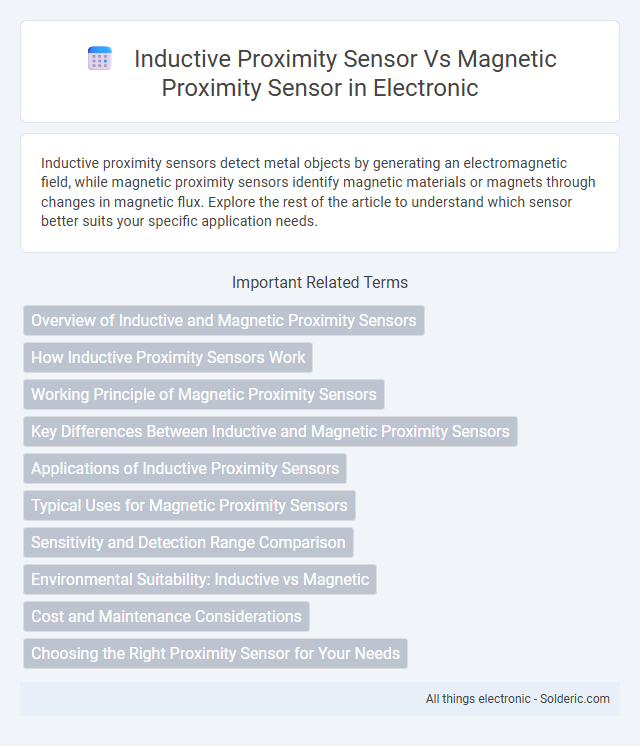Inductive proximity sensors detect metal objects by generating an electromagnetic field, while magnetic proximity sensors identify magnetic materials or magnets through changes in magnetic flux. Explore the rest of the article to understand which sensor better suits your specific application needs.
Comparison Table
| Feature | Inductive Proximity Sensor | Magnetic Proximity Sensor |
|---|---|---|
| Sensing Principle | Detects metal objects via electromagnetic fields | Detects magnetic fields or magnets |
| Target Objects | Metal only (ferrous and non-ferrous) | Magnetic materials or magnets |
| Detection Range | Short (typically 1-30 mm) | Variable, up to several centimeters or more |
| Environmental Resistance | High resistance to dirt, oil, and non-metallic contaminants | Effective in harsh conditions, unaffected by non-magnetic metals |
| Applications | Metal object detection, position sensing in automation | Magnet detection, reed switches, position sensing with magnets |
| Cost | Moderate | Varies, often lower for reed sensors |
| Output Type | Typically NPN/PNP transistor output | Varies; reed switches or Hall effect sensor outputs |
Overview of Inductive and Magnetic Proximity Sensors
Inductive proximity sensors detect metal objects by generating an electromagnetic field that changes when a conductive target enters the sensor's range, making them ideal for metal detection in industrial automation. Magnetic proximity sensors, often reed switches or Hall effect sensors, respond to the presence of magnetic fields, enabling detection of magnets or magnetic materials without direct contact. Your choice depends on the target material and application environment, with inductive sensors suited for metallic targets and magnetic sensors for magnetic sources or non-metal applications.
How Inductive Proximity Sensors Work
Inductive proximity sensors operate by generating an electromagnetic field through a coil, which induces eddy currents in nearby conductive metal objects, causing a change in the sensor's oscillation amplitude. This change is detected and converted into an electrical signal, indicating the presence of the object without physical contact. Unlike magnetic proximity sensors that rely on changes in magnetic fields, inductive sensors specifically target conductive materials, making them ideal for detecting metal objects in industrial automation.
Working Principle of Magnetic Proximity Sensors
Magnetic proximity sensors operate based on the detection of magnetic fields, using Hall effect or reed switch technology to sense the presence of a magnetic object. Unlike inductive proximity sensors, which detect metallic objects through electromagnetic induction, magnetic sensors specifically respond to changes in magnetic flux caused by magnets or ferrous materials. Your choice between these sensors depends on the application's need for detecting magnets versus general metal objects.
Key Differences Between Inductive and Magnetic Proximity Sensors
Inductive proximity sensors detect metallic objects using electromagnetic fields, while magnetic proximity sensors identify ferromagnetic materials through changes in magnetic flux. Inductive sensors operate effectively in environments with non-metallic contaminants, offering high precision for detecting metal targets without contact. Magnetic sensors excel in detecting magnets or magnetic materials regardless of the object's conductivity, making them suitable for applications requiring detection of both ferrous and some non-ferrous metals.
Applications of Inductive Proximity Sensors
Inductive proximity sensors are widely used in industrial automation for detecting metal objects without contact, making them ideal for assembly lines, robotic arms, and conveyor systems. These sensors excel in environments with dirt, oil, or water, offering reliable performance in harsh conditions such as manufacturing plants, packaging machinery, and automotive production. Their ability to detect ferrous and non-ferrous metals precisely enhances safety controls, position sensing, and speed monitoring in various automated systems.
Typical Uses for Magnetic Proximity Sensors
Magnetic proximity sensors are commonly used in applications where non-contact detection of ferromagnetic materials is required, such as in door and window security systems, industrial automation for position sensing, and automotive anti-lock braking systems (ABS). These sensors excel in harsh environments due to their resistance to dust, oil, and moisture, making them ideal for machinery monitoring and conveyor belt systems. You can rely on magnetic proximity sensors for precise and reliable detection in environments where inductive sensors might struggle with non-metallic interference.
Sensitivity and Detection Range Comparison
Inductive proximity sensors exhibit high sensitivity to metallic objects with a detection range typically up to 10-20 mm, optimized for ferrous materials. Magnetic proximity sensors detect magnetic fields and generally offer longer detection ranges, often exceeding 30 mm, depending on magnet strength and sensor type. Sensitivity in inductive sensors depends on target size and material conductivity, while magnetic sensors' detection range is influenced by magnetic flux density and sensor design.
Environmental Suitability: Inductive vs Magnetic
Inductive proximity sensors excel in detecting metal objects in harsh industrial environments, offering high immunity to dirt, oil, and moisture, making them ideal for applications with heavy contamination. Magnetic proximity sensors perform well in environments where non-metallic objects need detection, functioning reliably in dusty, wet, or corrosive conditions due to their magnetic field-based operation. Choosing between inductive and magnetic sensors depends on the specific environmental challenges and the target object's material properties.
Cost and Maintenance Considerations
Inductive proximity sensors generally have lower upfront costs and require minimal maintenance due to their robust design and lack of moving parts, making them suitable for detecting metal objects in harsh industrial environments. Magnetic proximity sensors tend to be more expensive initially because of their specialized components but often demand less frequent maintenance since they can operate effectively through non-metallic barriers and resist contaminants like dust and moisture. Overall, inductive sensors offer cost-effective durability for metal detection, while magnetic sensors provide longevity and reliability in challenging conditions with a higher initial investment.
Choosing the Right Proximity Sensor for Your Needs
Inductive proximity sensors excel at detecting metal objects without contact, making them ideal for industrial environments with metallic components. Magnetic proximity sensors detect magnetic fields, providing reliable sensing for both metallic and non-metallic targets, especially in harsh or dirty conditions. Understanding your application's material type and environmental factors ensures you choose the right proximity sensor to maximize accuracy and durability.
inductive proximity sensor vs magnetic proximity sensor Infographic

 solderic.com
solderic.com